Hydro G Final report - Kildare.ie
Hydro G Final report - Kildare.ie
Hydro G Final report - Kildare.ie
Create successful ePaper yourself
Turn your PDF publications into a flip-book with our unique Google optimized e-Paper software.
<strong>Hydro</strong>-G FINAL REPORT<br />
5. Conclusions and Recommendations<br />
5.1 F<strong>ie</strong>ld monitoring and data analysis suggest that water at the Leixlip Spa site originates from<br />
a complex groundwater system combining two sources.<br />
5.2 The main source of water comes from a deeper, older and warmer groundwater system,<br />
discharging through the Spa Well at the top of the first, most elevated, southern<br />
terrace. The second is a more recent, shallow groundwater that flows through the<br />
karstif<strong>ie</strong>d limestone bedrock with the main groundwater discharge located in the<br />
vicinity of the ‘filtering ponds’, which are also on the first terrace. Overland flow is<br />
also apparent.<br />
5.3 The majority of groundwater discharge locations were identif<strong>ie</strong>d within the 1st terrace.<br />
However, some discrete groundwater discharges exist also at the 2nd and 3rd<br />
terraces. No springs were identif<strong>ie</strong>d within the 4th or 5th terrace (floodplain).<br />
5.4 Rev<strong>ie</strong>w of historical information revealed that the upper (1st) terrace underwent a ser<strong>ie</strong>s of<br />
modifications which are likely to have altered the original, natural groundwater<br />
pathways within the site. The original outflow from the Spa Well was in the north<br />
westerly direction. The historical evidence suggests that the outflow was diverted<br />
towards the north easterly direction in late 1970s or early 1980s. Subsequently,<br />
water from the Spa Well flows towards the cold springs (‘filtering ponds’). The<br />
implication of such engineering is limitation in water delivery to the western side of<br />
the 1st terrace manifested in drying of this wet-grassland habitat. To verify this<br />
hypothesis, further investigation is necessary and this could, for example, include<br />
geophysical or drain camera surveys that would determine the original layout of the<br />
Spa Well discharge pipe. It is also possible that diversion of the groundwater flow<br />
away from the western side of the 1st terrace occurred unintentionally during sewage<br />
works undertaken in 1980s. Knowledge of the exact location of service pipes within<br />
the upper extent of the site would also benefit the conceptualisation of groundwater<br />
flows at this location. If this hypothesis is confirmed, the subsequent mitigation<br />
measures would include reengineering the pipe layout so they could allow the Spa<br />
Well discharge to flow in north – north westerly direction. However, this will result in<br />
a reduction of groundwater flow towards the cold springs (‘filtering ponds’) and is<br />
likely to impact on the local ecology surrounding the ‘filtering ponds’ which have<br />
adjusted to present conditions over time. Considering a probable local recharge of<br />
the cold springs, redirection of the groundwater discharge from the Spa Well might<br />
cause an increase in seasonal variation in water levels in the ‘filtering ponds’ area<br />
and could cause seasonal drying of the fen wetland. <strong>Hydro</strong>chemical changes could<br />
also occur. Redirection of the outflow from the Spa Well, away from the ‘filtering<br />
ponds’, will also reduce the volume of water cascading to the second terrace at the<br />
eastern side and this will affect distribution of water at down grad<strong>ie</strong>nt terraces. This<br />
is likely to be compensated by more water flowing on the western side but is likely to<br />
lead to habitat transformations on a local scale.<br />
5.5 F<strong>ie</strong>ld data suggest that the Intel boundary drain does not currently act as a drainage<br />
channel drawing groundwater from the wet-grassland habitat which has been<br />
<strong>report</strong>ed to be drying out. Data from a groundwater monitoring well on the Intel site<br />
Project No.: 07_136 -15-<br />
Leixlip Spa
















